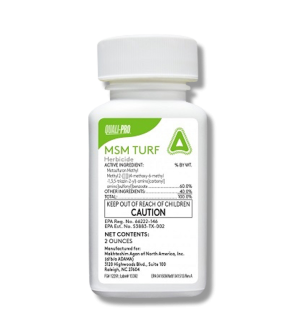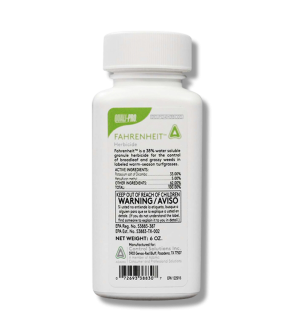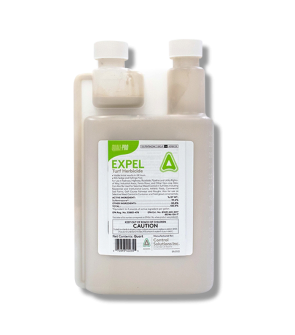Common Groundsel
Most Effective Products
Common Groundsel: How to Get Rid of Common Groundsel
This page is a general common groundsel control guide that will completely remove these broadleaf weeds from your property. Follow this DIY guide and use the recommended products and we guarantee you will be successful in removing common groundsel from your lawn in a quick and affordable manner.
Common groundsel is a regular winter annual weed that is typically found in greenhouses, nurseries, plant beds, gardens, crops, and sometimes lawns. While this Asteraceae family weed is classified as a winter annual due to its ability to germinate during cool temperatures it is also classified as a summer annual. However, conditions for this weed to survive in the summer must be relatively cool with consistent shade.
The distinguishing characteristic of this broadleaf weed is its ability to produce a heavy amount of seeds within a short time frame and to self-pollinate without the aid of another plant. Making physical removal of common groundsel strenuous without the aid of products containing isoxaben and dicamba. Additionally, common groundsel is especially problematic to livestock being fed crops containing this weed. Foliage and stems of this broadleaf weed contain toxic alkaloids, which can cause chronic liver damage if ingested by cattle, horses, and swine.
Usually most weed species create fungi diseases, because they are absorbing the moisture and nutrients from the area. While common groundsel can also perform this task it is also a carrier for fungi pathogens that results in black rot and leaf rust. None of these diseases are ideal, but they are especially problematic to agricultural crops and nursery farms.
By following this DIY guide, you will learn how to completely remove common groundsel from your property through each step listed in this article and with the recommended professional quality herbicide products.
Identification
Before you can proceed with treatment of common groundsel, you will need to make sure the weed infesting your targeted area is the appropriate weed. Misidentification can lead you to using the wrong products, which leads to waste of time and money. Listed below are the traits associated with common groundsel to properly identify the weed.

- When common groundsel is young, the plant grows as a rosette with an alternating leaf arrangement. Common groundsel’s first true leaves are attached to the stem with a petiole, but later leaves will grow straight from the stem itself. Note the deep lobes and the jagged edges.
- As the plant matures, the stem grows upright, up to 2 feet tall if the plant sees full sunlight. Common groundsel grows several branches, each growing several flower heads.
- When in bloom, the flower heads grow yellow flowers and usually appear as if they are closed up, but they can rarely grow to appear more like dandelion flowers. They will even produce white, fluffy seed heads like dandelions when the plant reaches maturity.
- Leaves of young common groundsels will be dark green, slightly lobed and often purplish on the underside of the leaf and lower stem. Mature leaves are 2 to 4 inches long with deep, scraggly lobes with toothed margins and attached to the purplish stem.
Use the above image and description to help you properly identify common groundsel. For further questions or discussions, you can always contact one of our trained professionals by phone, email, or visit one of our stores.
Inspection
After you have properly identified common groundsel, you can proceed with inspection. During this phase, you will need to locate where common groundsel is growing, conditions for growth, and the size of current population. Learning this information will help determine where to apply herbicide applications and appropriate products to use.

Where to Inspect
Common groundsel is a cool-season broadleaf weed. It’s considered a winter annual, but can also be regarded as a summer annual in areas where the summers stay cool enough.
It spreads by its tuft, white hairs on top of the seed, which helps the wind to carry the seed across multiple distances. Ornamental flower beds, roadsides, plant beds, gardens, crops, greenhouses, nurseries, and undisturbed areas exposed to consistent moisture and shade are the most common places to find common groundsel.
What to Look For
Common groundsel typically germinates from late fall to early spring. It will reach maturity and produce seeds towards the late spring and early summer, then die as the summer warms up.
As the plant matures, the stems and leaves will appear to be weaker and bend with the weight of developing yellow flower heads. Once the flower opens, it will produce a seed topped with fluffy dandelion like hairs that allows the seeds to travel and spread by the wind.
Treatment
Before handling and mixing any herbicide products, you will need to wear the appropriate personal protective equipment (PPE).
The most effective way to handle common groundsel is to apply a pre-emergent herbicide that is labeled to treat this weed. Timing will depend on your regions pattern of cool-weather, but it is best to apply several weeks before fall and winter weather as this is the ideal germination period.
Herbicides containing sulfentrazone, isoxaben, dicamba, or halosulfuron as its active ingredient will work best against common groundsel.
If you missed this time period and have present common grounsel infestations, we recommend making a post-emergent herbicide application with Fahrenheit Herbicide.
Step 1: Apply Pre-Emergent Herbicide

Expel Turf Herbicide is a pre-emergent herbicide that will repel and control numerous types of weeds such as common groundsel before they emerge in your lawn, landscape plants, field and container grown ornamentals, and other types of terrains.
Determine how much product you will need by measuring the square footage of the treatment area. To do this, measure and multiply the areas length and width in feet (length X width = square footage). Follow this formula for the following step.
To prevent common groundsel in cool-seasoned turf, use 4 to 8 fl. oz. of Expel Turf Herbicide in 10 gallons of water per acre. For warm-seasoned turf, use 8 to 12 oz. of product per 10 gallons of water per acre.
Fill your selected sprayer halfway with water, then add the appropriate amount of Isoxaben 75WG, and fill the rest of the way with remaining half of water. Close the lid to the spray tank and shake to ensure an even mixture.
Apply to the soil if weed is not present or to the leaves of weeds above ground until the point of wet, but not runoff. The treated area should recieve at least 0.25 inches of water after application.
Step 2: Apply Post-Emergent Herbicide

For common groundsel weeds that have already emerged, apply Fahrenheit herbicide. Fahrenheit Herbicide is a water soluble granule that should only be applied to warm-seasoned turf.
To control common groundsel, apply 6 to 12 oz of Fahrenheit Herbicide in 20 to 80 gallons of water per 1 acre of treatment area. In smaller spaces, we recommend the listed spot application rate of 0.2 oz of the product mixed with 1 gallon of water to treat 1,000 sq. ft.
Pour half of the appropriate amount of water, then add the measured amount of product, and fill the rest of the way with the remaining half of water.
Close the lid to the sprayer tank and shake to ensure an even mixture. Spray the top and bottom of the common groundsel leaves until wet, but not to the point of run-off.
A repeat application may be required in 4 to 6 weeks for either product being used.
Prevention
After the common groundsel is removed from your property, you should implement some preventative measures to ensure these weeds do not return. These preventative measures to take is listed below.

- Common groundsel is a noxious weed that is found within ornamental plants and plant beds. Since this plant typically reproduces through its dandelion-like seeds it would be best to cut off the top of the common groundsel and drag the plant out until its roots are exposed with a garden hoe or gloved hands.
- Maintain a pre-emergent herbicide application with Expel Turf Herbicide prior to the fall and summer season to fight against common groundsel weeds before they emerge.
- Keep edges of yard, hedgerows, and lawn maintained with a regular mowing schedule. Mow when turf has reached a height of 3 to 4 inches. Consistent mowing will help to eliminate seeds that have just landed on your turf by wind.
- Replace fertilizer in ornamental plants to remove excessive moisture and provide foliage with the appropriate amount of nutrients to fight against weeds like common groundsel.
Key Takeaways
What are Common Groundsel?
- Common groundsel is a noxious weed that typically invades plant beds and sometimes lawns. It has the distinct appearance of dandelions when seeds are in bloom and prior to bloomage its leaves will have toothed margins and closed cylindrical shaped yellow flowers.
How to Get Rid of Common Groundsel
- Common groundsel should be treated prior to germination with a pre-emergent herbicide like Isoxaben 75WG. Apply Fahrenheit herbicide or MSM Turf when weeds have already emerged in your property.
Preventing Common Groundsel
- Prevent common groundsel infestations with a pre-emergent product like Isoxaben 75WG and maintain a regular mowing schedule to promote thick turf growth and cease seed activity before it reaches soil.














































































































































































































































































































































































































































































































































